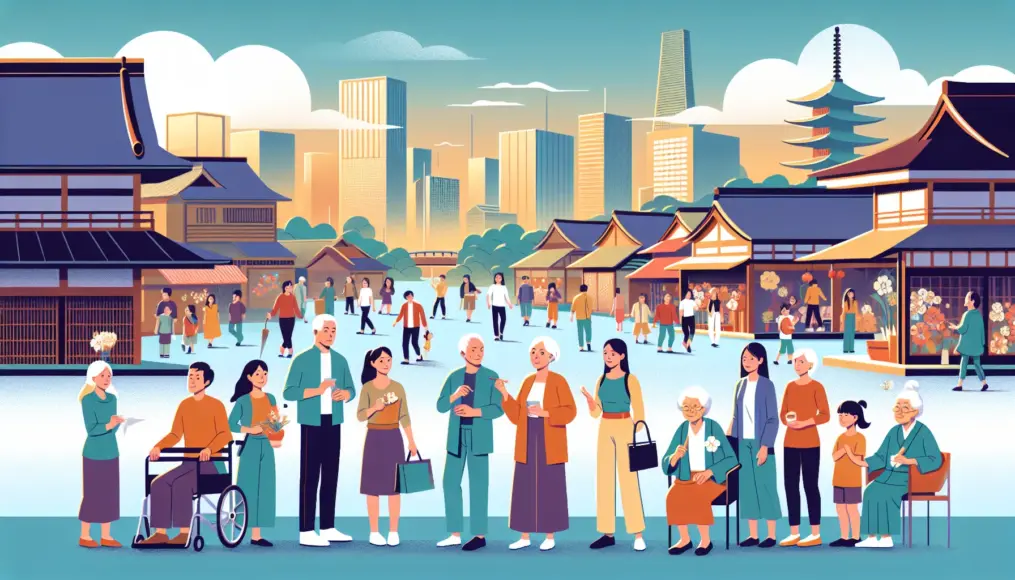Japan’s declining birthrate and aging population present significant challenges for our society. However, by approaching this issue from a cultural perspective, we might uncover new solutions. Cultural activities and connections within local communities hold the potential to combat the effects of demographic shifts. When people come together to share experiences and joy, vibrant communities can flourish.
In this article, we will delve into cultural approaches to address the aging population problem. We will consider the importance of policies aimed at revitalizing communities through traditional culture and fostering multicultural coexistence. Let’s explore how we can collaboratively tackle this pressing issue.
- The Impact of Cultural Activities on Declining Birthrates and Aging Populations
- Revitalizing Communities through the Reevaluation of Traditional Culture
- Concrete Efforts Towards Realizing a Multicultural Society
The Impact of Culture on Addressing Aging Population and Declining Birth Rates
The issues of an aging population and declining birth rates are impacting our society in various ways, yet the role of cultural activities in addressing these challenges is often overlooked. Culture has the power to connect people, serving as a vital element for community revitalization and social cohesion. Through cultural events, intergenerational exchanges and community bonds can be strengthened, potentially providing solutions to the challenges posed by demographic shifts.
In this section, we’ll explore the significance of cultural activities and the importance of local communities. We’ll examine how these activities foster connections among individuals and empower neighborhoods.
The Role of Cultural Activities
Cultural activities provide a space for local residents to gather and deepen their connections. This leads to interactions that transcend generations, fostering vibrant communication between the young and the elderly. By sharing local traditions and cultural practices, participants can reaffirm their identities and take pride in their heritage.
Moreover, cultural activities positively impact the local economy. Events and festivals attract tourists, which boosts sales of locally-produced goods. This economic dimension can serve as a resource in overcoming the challenges posed by an aging society and declining birth rates.
- Promoting intergenerational exchanges through cultural activities
- Nurturing local identity and pride
- Contributing to the revitalization of the local economy
The Importance of Local Communities
Local communities serve as the foundation for tackling the challenges of an aging population and declining birth rates. When a community is revitalized, it becomes easier for people to come together, leading to a variety of activities. This fosters a sense of unity and cultivates a culture of mutual support. Especially when older adults engage in community activities, their experiences and knowledge can be invaluable learning opportunities for younger generations.
When a community is bound by strong ties, it enables flexible responses to the issues of an aging society. By coming together, communities can enhance their collective power to address these challenges.
- Revitalized communities connect individuals
- Leveraging the experiences of older adults in the community
- Strengthening unity to enhance responses to demographic challenges
Revitalizing Communities through Traditional Culture
As Japan faces an aging population and a declining birthrate, reevaluating local traditional cultures plays a crucial role in community revitalization. Traditional events and cultural practices strengthen the connections within communities, providing opportunities for empathy and engagement. These cultural activities breathe new life into the area, creating spaces where both young people and the elderly can come together.
In this section, we will explore how reassessing traditional events and promoting local culture can serve as a strategy to address the challenges of a declining population. We’ll examine how community-rooted culture can invigorate regions and contribute to building a sustainable society.
Reassessing Traditional Events
Traditional events held in communities are vital in nurturing cultural identity. However, their significance is often overlooked in today’s society. By reevaluating these events, we can pass on the history and culture of the region to future generations. Additionally, when community members come together to support these events, it deepens the bonds within the community.
Moreover, looking at traditional events from a fresh perspective can expand their potential as tourist attractions. By drawing in visitors from outside the region, these events can contribute to the revitalization of the local economy.
- Traditional events foster regional identity
- Provide opportunities to strengthen community ties
- Reevaluation as tourist attractions contributes to the economy
Promoting the Charms of Local Culture
Sharing the appeal of local culture is an essential element of community revitalization. By promoting regional specialties and traditional crafts, we can introduce the allure of the area to outsiders. This, in turn, enhances the region’s value and is expected to attract tourists and new residents.
Utilizing social media and local events to promote local culture is also crucial. When young people actively participate, new ideas and perspectives emerge, allowing regional culture to evolve further.
Reassessing local traditional culture is indispensable for revitalizing communities. If you’re interested in this topic, we recommend checking out this article: “Practical Approaches to Solve the Declining Birthrate!.” It provides specific methods related to promoting local culture and tackling the declining birthrate, so be sure to take a look!
- The importance of communicating local culture to outsiders
- Enhancing regional value through the promotion of specialties and traditional crafts
- Methods of communication using social media and local events
Realizing a Multicultural Society
As Japan faces a declining birthrate and an aging population, the importance of fostering a multicultural society has become a pressing issue. When foreign communities integrate into local areas, diverse cultures and values can interact, leading to the revitalization of the entire community. By living alongside people from different backgrounds, the richness of local diversity increases, providing more opportunities for mutual learning.
In this section, we will explore the coexistence with foreign communities and the promotion of intercultural exchange. Let’s delve into how multicultural coexistence can address issues related to the declining birthrate and aging population, while also discovering ways to improve our communities.
Coexisting with Foreign Communities
Coexisting with foreign communities is crucial in tackling the challenges posed by a declining birthrate and an aging population. The skills and knowledge that foreign residents bring to a locality can be a tremendous asset for local people. As they become rooted in the community, we can expect to secure labor and invigorate the local economy.
Moreover, through interactions with foreigners, local residents can develop a greater understanding and acceptance of different cultures. This helps cultivate an environment in which diversity is respected and collaboration is fostered. When the spirit of coexistence takes hold, the entire community thrives.
- Utilizing the skills and knowledge foreigners bring to the community
- Securing labor and revitalizing the local economy
- Fostering a spirit of coexistence that promotes cultural understanding
Promoting Intercultural Exchange
Intercultural exchange is an indispensable element in building a multicultural society. It’s essential to create more opportunities for people from different cultures to interact through local events and workshops. This allows residents to gain new perspectives and build enriching relationships.
Additionally, intercultural exchange can enhance the attractiveness of a region. By showcasing the cultures, cuisines, and arts of foreign residents, communities can draw in tourists. This revitalization fosters an environment conducive to addressing the challenges of a declining birthrate and an aging population.
If you’re interested in this topic, you might also want to check out this article that delves into the impact of declining birthrates on the economy and society: “Considering the Economic and Social Impacts of Declining Birthrates.” It offers deeper insights into the connection between achieving a multicultural society and addressing the challenges of a declining birthrate.
- The importance of interaction through local events and workshops
- Providing opportunities to gain new perspectives
- Promoting the appeal of different cultures as a tourist attraction
Striving for a Sustainable Society
In today’s society, characterized by a declining birthrate and an aging population, the active participation of young people in cultural activities is crucial for achieving a sustainable future. When younger generations engage in cultural endeavors, they not only breathe life into their communities but also cultivate a new sense of identity that can be passed down to the next generation. Additionally, a reevaluation of cultural policies and the introduction of innovative initiatives will serve as a foundation for supporting the society of tomorrow.
In this section, we will explore the importance of encouraging youth participation in culture and the necessary cultural policies for the future. Let’s examine the perspectives and actions needed to build a sustainable society.
Encouraging Youth Participation in Culture
When young people participate in cultural activities, it revitalizes their communities. Through these engagements, they shape their identities and strengthen their connections to their local areas. Especially events and projects led by youth can foster interactions across generations, injecting fresh energy into the community as a whole.
Moreover, young people’s involvement in cultural activities helps pass on local traditions and values to the next generation. Their innovative perspectives and ideas can become catalysts for the evolution of local culture.
- Youth participation revitalizes communities
- Shaping identity and strengthening local connections
- Fresh perspectives drive cultural development
Cultural Policies for the Future
To aim for a sustainable society, it’s essential to reassess cultural policies with a forward-looking approach. By developing cultural policies tailored to the unique characteristics and needs of each community, we can create an environment where both young people and the elderly can participate together. Securing resources to support local cultural activities and building sustainable models are also vital.
Furthermore, cultural policies contribute to the promotion of the local economy. When cultural activities thrive, tourism and local industries flourish, ultimately leading to the overall development of the region.
- Reevaluated cultural policies support a sustainable society
- Importance of policies tailored to local characteristics
- Revitalizing cultural activities boosts the local economy
Conclusion
Addressing the challenges of an aging population and declining birth rates requires more than just revising policies; it calls for a community-wide approach that leverages local culture. By promoting intergenerational interactions through cultural activities and respecting local traditions and diversity, we can invigorate our communities. Encouraging youth participation and fostering coexistence with foreign communities will enhance the appeal of our neighborhoods and lay the groundwork for a sustainable society.
These initiatives will have a positive impact on all generations, brightening the future of our communities. Taking a cultural perspective to tackle the issues of an aging population is key to unlocking the potential of our regions.
- Cultural activities foster intergenerational exchange
- Multicultural coexistence contributes to community revitalization
- Youth participation energizes local society
Our future is built on cherishing local culture. We’d love to hear your thoughts and opinions in the comments!



Comment